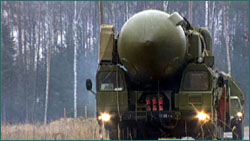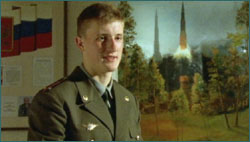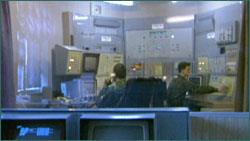|
 |
 |
|
|  "We were on the doorstep of a
mighty nuclear arsenal." Above, a TOPOL M astride a Russian mobile missile
launcher.
"We were on the doorstep of a
mighty nuclear arsenal." Above, a TOPOL M astride a Russian mobile missile
launcher.
|
The Director's Story:
Behind Russia's Nuclear Front Line
Part 2 | Back to Part 1
Inside the base, a closed city of 20,000 people, we met the roketchiki.
In a building on the main square, which was still dominated by a gilded statue
of Lenin, we were ushered into a vast and formal hall in the officer's club.
With Pozner and Nadelson, I faced an array of two dozen officers arranged
around a semicircular table. For two hours, we questioned one another, and we
began to connect with some individuals. The three of us film people were
immediately intrigued by a confident colonel with a gold tooth, and by a bright
young lieutenant who clearly understood English. Most of the officers had seen
the film I'd made with the American missileers, and they weren't especially
impressed by what they'd seen of their opposite numbers. "They only do this job
for about four years," one man said. "For us, this is a lifelong
commitment."
The sense of pride we encountered at that first meeting was to run through our
filming. The base was shabby, and life was clearly tough for the
roketchiki. We were told that a colonel in charge of massive nuclear
strike forces earns less than $60 per month. But compared with the desperate
village just outside the gates, a tangle of muddy lanes and decaying wooden
houses, life on the base was clearly privileged. And we were regularly made
aware that despite the hardships of life for the missile forces, the
roketchiki have preserved their feelings of patriotic duty. We filmed
the missile forces' entertainment troupe singing a hearty anthem about "the
defense of the motherland through the rocket's fierce flame," and for all the
inescapable echoes of a Mel Brooks fantasy, it was impossible to deny the sense
of commitment and dedication.
 Lieutenant Evgeny Pavlov
Lieutenant Evgeny Pavlov
|
|
The roketchiki had proposed some individual officers to be filmed, but
accepted without question when we chose instead to feature the gold-toothed
Colonel Petrovsky and the bright young Lieutenant Evgeny Pavlov. To my
surprise, we had as much freedom to choose our characters as we'd had on the
base in America. In both countries, we had an accompanying escort when we
filmed—in the U.S., a Press Office sergeant, in Russia a silent and rather
forbidding security man. Neither of them prevented us asking anything, but I
was startled to find the Russian escort less attentive than his American
equivalent. He rarely showed up for our interviews, whereas in Wyoming, our
press officer sat in on every conversation.
Eleventh-hour breakthrough
As I'd always expected, it was in gaining access to operational areas that we had
our greatest problems. In the U.S., after careful negotiation, we'd been able
to get up close and personal with the missileers in their underground launch
control capsules, and with the Minuteman missiles in their silos. In Russia, we
were dealing with a deeply ingrained culture of secrecy. As we came to the
final week of our filming, it became clear that something of a struggle was
going on behind the scenes. The base commander, a chunky and likable veteran,
was keen to open every door and show his pride in the roketchiki. But
despite Pozner's lobbying on the base and in Moscow, some of those doors
remained closed. It seemed that we were part of that top-level conflict between
missile people eager to display their abilities, and powerful military rivals
anxious to cut the roketchiki down to size.
|  Inner
sanctum: The TOPOL command center
Inner
sanctum: The TOPOL command center
|
On our final afternoon, we had a breakthrough. On a few minutes notice, we were
suddenly taken out to a missile launch control center. The base commander had
either won his battle—or taken a considerable risk. We filmed deep
underground in the tunnels built to withstand a direct nuclear strike, and I
felt I was back in the depths of a Cold War nightmare. But the undeniable fact
that I was there and filming with a Western crew meant that the Cold War was
over, and we had all moved on.
We had to survive one final banquet with the roketchiki. We struggled to
control the vodka attack and stay coherent for the final speeches. As we were
leaving, Colonel Petrovsky unpinned his missileers badge and gave it to me. In
the end, my overwhelming feeling was identical to the one I'd had at the end of
filming with America's missile squadrons. Given these monstrous weapons still
exist, thank goodness the keys are in such sane and responsible hands.

|
|
Leslie Woodhead, producer of the NOVA program "Russia's Nuclear Warriors," has
made numerous documentaries since the 1960s. Recent efforts include a film
about the Srebenica Massacre, which won Grand Prize at the Banff TV Festival,
the Amnesty U.S. Documentary Award, and the Robert F. Kennedy Journalism Award.
Woodhead also recently completed a nonfiction feature, "Endurance," about an
Olympic gold medal long-distance runner. See Woodhead's thoughtful piece on the
making of the NOVA program "Holocaust on Trial." |
Photos: (1-7) WGBH/NOVA; (8) Courtesy of Leslie Woodhead.
The Director's Story |
False Alarms on the Nuclear Front
Global Guide to Nuclear Missiles |
From First Alert to Missile Launch
Resources |
Transcript |
Site Map |
Russia's Nuclear Warriors Home
Search |
Site Map |
Previously Featured |
Schedule |
Feedback |
Teachers |
Shop
Join Us/E-Mail |
About NOVA |
Editor's Picks |
Watch NOVAs online |
To print
PBS Online |
NOVA Online |
WGBH
© | Updated October 2001
|
|
|
|